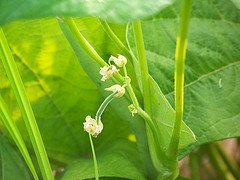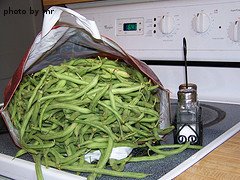Fertilizing and Watering Green Beans Made Easy!
When it comes to watering green beans, moderation is the key. Green bean plants only need 1/2 inch of water per week to thrive and produce high quality and quantities of green beans. In many cases, you'll get enough rain so that you won't have to water. Moderation is also key when fertilizing green beans. The plants tend to thrive in a variety of soils, even poor ones, and they don't require a ton of fertilizer.

Watering Green Beans
When watering your bean plants, try to avoid watering the tops of the plants. Instead, focus your efforts on the root systems. This will allow the plants to absorb the most moisture. You should water in the early morning hours. This lets the mid-day sun evaporate any unused water. If water sits on the tops of the plants for extended periods of time, it may encourage mildew to develop on the leaves and pods. If no rain falls, a deep soak once a week should be sufficient. If the plant does not receive adequate water, it may cause the blossoms to drop off the plant. No blossoms mean no green beans, so an adequate water supply is necessary for the plants to thrive.
In our own garden, we just use an oscilating sprinkler to water our green beans. And since we usually get enough rain, we usually only end up watering our beans a couple of times per growing season.
A great way to tell if your bean plants need water is to use your fingers to dig down 4 inches or so into the soil next to the plants. You want the soil at this depth to be moist but not wet. Grab a handful of soil and squeeze it in your palm. You want it to hold together for a couple of seconds before falling apart. If the soil is bone dry and doesn't hold together at all, you need to water your plants. If the soil is soggy and holds together for more than a few seconds when squeezed, you should let it dry out for a few days and check again. Green bean plants don't do well if they sit in soggy soil for extended periods. Moist soil is good, dry soil and soggy soil is bad.
Fertilizing Green Beans
Green bean plants can be fertilized once every 4-6 weeks throughout the growing season, if the plants need it. A balanced fertilizer will usually do the job nicely. Look at the 3 digit formula on the fertilizer - you want close to equal parts of nitrogen, phosphate and potassium. This will result in good plant health as well as good bean production. Something like a 10-10-10 fertilizer will work just fine. Most granular type fertilizers are applied at a rate of 1.5 pounds per 100 square feet. Apply the granules according to the manufacturer's instructions. They should be applied at the edges of the rows and not thrown directly on the plants themselves. Once a granular fertilizer is applied, water it in well. This will allow the fertilizer to enter the soil and be absorbed by the root systems.
If you choose to use a water soluble type fertilizer, apply it according to the manufacturer's directions. A hose end sprayer is convenient for applying water soluble fertilizer. But depending on how many plants you have, a watering can or pitcher can also work nicely.
In our garden, we apply a granule fertilizer a few days before we plant. We scatter the granules at a rate of about 1 pint per 100 square feet. We also scatter pulverized lime, as our soil is slightly acidic and calcium deficient. We then water in the fertilizer and lime, wait a couple of days and then till the soil one last time. This ensures that the fertilizer is distributed throughout the soil. We then build our raised rows and plant our bean seeds. Then, we switch to a water soluble fertilizer and apply that about once a month during the growing season, using a hose-end sprayer. We typically wait to start fertilizing the bean plants after they are a few inches tall.
A layer of mulch can be applied to the green bean plants to help regulate soil moisture and temperature levels, but it's certainly not mandatory. Grass clippings, chopped up leaves or hay work well for mulch. Additionally, mulch can help prevent the growth of weeds in your garden.
After fertilizing, mulching and watering green beans, the only thing left to do is harvest them.

Click here to learn about harvesting green beans
Click here for green bean recipe ideas
Click here to leave the Watering Green Beans page and return to the Growing Green Beans main page
Click here to return to our Home page